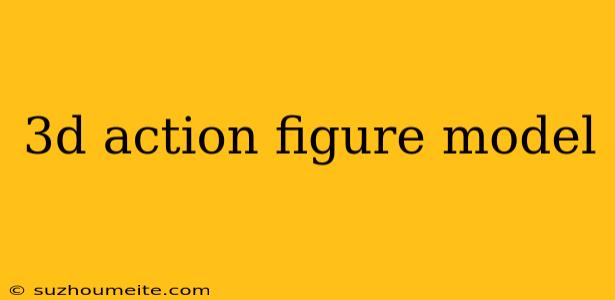3D Action Figure Model: Bringing Your Favorite Characters to Life
Are you a fan of action figures and 3D modeling? Do you want to create your own unique action figure model that stands out from the rest? Look no further! In this article, we'll delve into the world of 3D action figure modeling, exploring the process of creating a stunning 3D model that brings your favorite characters to life.
What is a 3D Action Figure Model?
A 3D action figure model is a digital representation of an action figure, created using 3D modeling software. It's a virtual replica of a physical action figure, but with the added benefits of being highly customizable and easily shareable. With 3D modeling, you can create intricate details, complex poses, and dynamic scenes that would be impossible to achieve with traditional action figures.
The Process of Creating a 3D Action Figure Model
Creating a 3D action figure model involves several steps:
Step 1: Concept and Reference Gathering
Before starting to model, gather reference images of your favorite character or action figure. Collect images from different angles, showcasing the character's pose, facial expression, and costume details. This will help you understand the character's anatomy and costume design.
Step 2: Choosing the Right 3D Modeling Software
Select a 3D modeling software that suits your skill level and preferred workflow.Popular choices include Blender, Maya, and 3ds Max. Familiarize yourself with the software's interface and tools to ensure a smooth modeling experience.
Step 3: Blocking Out the Model
Start by blocking out the basic shape of the character using simple geometric shapes. This will help you establish the overall proportions and pose of the model. Refine the model by adding more details, such as facial features, costume elements, and accessories.
Step 4: Adding Details and Textures
Add finer details, such as wrinkles, scars, or tattoos, to give your model a more realistic appearance. Apply textures and materials to enhance the model's visual fidelity. You can use pre-made textures or create your own using image editing software.
Step 5: Rigging and Animation
Set up a skeleton for your model to enable posing and animation. This will allow you to create dynamic scenes and interactions between multiple characters. You can use pre-made rigs or create your own using scripting languages like Python or MEL.
Step 6: Rendering and Lighting
Set up a scene with a suitable environment, lighting, and camera angles to showcase your model. Experiment with different rendering styles, such as realistic or stylized, to achieve the desired aesthetic.
Tips and Tricks
- Keep it simple: Start with a simple model and gradually add complexity as you become more comfortable with the software.
- Use reference images: Continuously refer to your reference images to ensure accuracy and consistency.
- Experiment and have fun: Don't be afraid to try new things and make mistakes – it's all part of the learning process!
Conclusion
Creating a 3D action figure model is a rewarding experience that combines creativity, technical skills, and attention to detail. With practice and patience, you can bring your favorite characters to life in stunning 3D. Share your creations with the world, and who knows – you might just inspire a new generation of 3D modelers and action figure enthusiasts!
